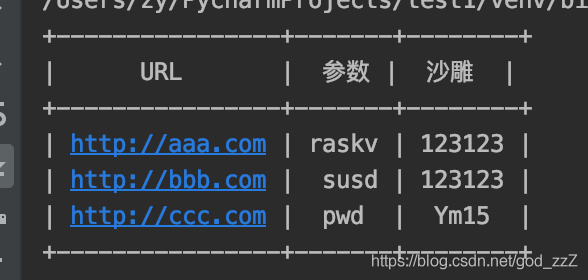- Python通过prettytable模块将输出内容如表格输出 比自己那个高端的多了
1安装得有吧
2导入模块
1
| import prettytable as pt
|
直接给例子
1
2
3
4
5
6
7
8
9
10
11
12
13
14
15
| import prettytable as pt
# 添加表头
table = pt.PrettyTable(["URL", "参数", "沙雕"])
# add_row 添加一行数据
table.add_row(["http://aaa.com", "raskv", "123123"])
table.add_row(["http://bbb.com", "susd", "123123"])
table.add_row(["http://ccc.com", "pwd", "Ym15"])
# 默认居中对齐
# 设置"值"列,局左对齐 left首字母
table.align["值"] = 'l'
print(table)
|
输出,可以哇

1
2
3
4
5
6
7
8
9
10
11
| from prettytable import PrettyTable
table = PrettyTable()
# add_column 添加一列数据
table.add_column('===', ["URL", "参数", "值"])
table.add_column('第1列', ["http://aaa.com", "raskv", "dEBxcS5j"])
table.add_column('第2列', ["http://bbb.com", "su", "626d5633583231794c6d4e6"])
table.add_column('第3列', ["http://ccc.com", "pwd", "Ym1WM1gyMXlMbU5"])
# 设置"第3列",局右对齐 right首字母
table.align["第3列"] = 'r'
print(table)
|
进度条
import time
import progressbar
可以是迭代器或列表
1
2
3
4
5
6
7
8
9
| p = progressbar.ProgressBar()
my_list = [1, 2, 3, 4, 5]
my_list.append([6, 7, 8, 9])
for i in p(my_list):
# do something
print(i)
time.sleep(1)
|





